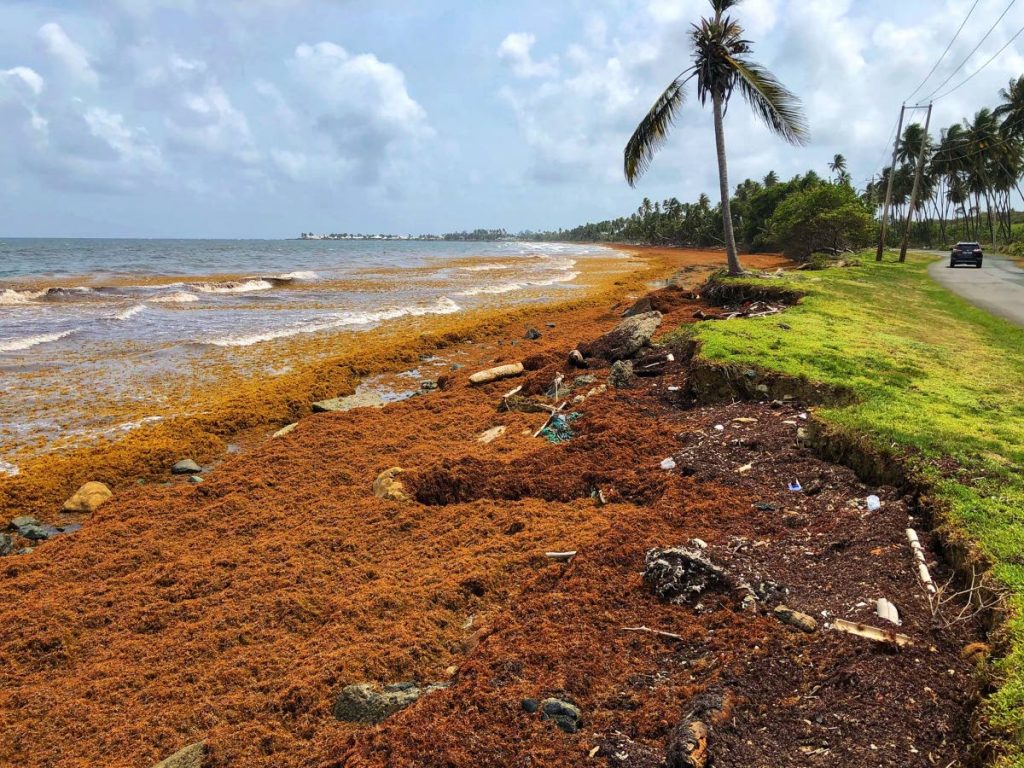Sargasssum brings another ‘golden tide’ on our shorelines

Rahanna Juman,
Institute of Marine Affairs
For yet another year, massive quantities of sargassum are seen washing up along our coasts and is causing concern among fisherfolk and other beach users. This new source of sargassum is now linked to climate change and ocean eutrophication, and these are likely to continue supporting significant sargassum blooms into the future. As such, annual mass influxes of sargassum into the Caribbean Sea are now being considered as the new normal, requiring sustainable management responses and long-term adaptation (Desrochers et al. 2020).
Pelagic (free-floating) sargassum, a brown algae from the equatorial Atlantic, comprises a mixture of two or possibly three different sargassum species, namely sargassum fluitans III, sargassum natans I, and sargassum natans VIII (Schell, Goodwin, and Siuda 2015) that forms large floating mats often referred to as “golden tides.” These species are unique in that they are the only sargassum species to spend their entire lifecycle afloat, instead of attached to the seafloor. As such, they are considered to be holopelagic, and to only occur in the Atlantic Ocean (Desrochers et al. 2020). The Atlantic holopelagic sargassum is also thought to only reproduce vegetatively through growth and fragmentation, and is able to double its biomass very quickly under the right conditions (nine to 20 days; Hanisak and Samuel 1987, Lapointe 1986).
Field surveys and satellite maps have indicated that sargassum blossoms naturally in the warm waters of the Atlantic Ocean; the Tropical South Atlantic and in the North Atlantic including the Sargasso Sea. Since 2011, there have been several episodes of unusual quantities of sargassum reaching the coasts of many of the islands of the Caribbean Sea and West Africa, but where is it coming from?
In 2013, satellite images showed sargassum concentrated in the tropical North Atlantic over 600 km offshore from South America, to the north and west of the mouth of the Amazon River. For about 18 months prior to landing in 2013, a trace from the sargassum sighting location was made using a high-resolution numerical ocean current model, which pointed to waters near the North Equatorial Recirculation Region (NERR) (Johnson et al. 2013). Sargassum may be aggregating in the NERR region and blooming there.
More recent satellite images revealed increasing trends in sargassum amounts in both the tropical Atlantic and the Caribbean through 2018. Floating sargassum travels with ocean currents and is influenced by surface winds. However, the currents that have resulted in the movement of more sargassum into the Eastern Caribbean and Northwest African coastlines are not clear at this time (UNEP, 2018).
Massive sargassum pile up has disrupted fisheries and has had devastating impacts on tourism, damaged critical nearshore ecosystems and coastal livelihoods, as well as caused significant health challenges for populations exposed to rotting sargassum (UNEP 2018). The ecological impacts are still being assessed, but massive influx of sargassum has resulted in the potential disturbance of marine life, beach fouling, and coastal dead zones.
The accumulation and decay of large amounts of sargassum in the water can result in anoxia and the release of poisonous hydrogen sulphide, potentially causing the death of marine life. Entanglement of foraging turtles in the sargassum rafts, and blockage of turtle nesting sites by the seaweed that covers the beach also represent a threat to turtle populations, with Trinidad and Tobago being one of the largest leatherback turtle nesting sites in the Atlantic.
The current cost and manpower required to repeatedly clean and dispose of stranded sargassum are unsustainable. Furthermore, the loss of revenue from the tourism industry, in particular, fisheries and other coastal livelihoods are affecting national economies and is, therefore, a concern for many countries (Desrochers et al. 2020). As such, there is a rapidly growing interest across the region aimed at turning this hazard into a benefit by developing industries that can utilise stranded sargassum as a raw material (UNEP 2018).
Many entrepreneurs and research teams across the wider Caribbean region have been working arduously over the past few years to raise funds and develop innovative businesses and projects to use sargassum as raw material for the pharmaceuticals, food, cosmetics, textile, medical, agricultural, paper, construction, bioenergy lubricant, adhesive and bioplastic industries (Desrochers et al. 2020). The Centre for Resource Management and Environmental Studies (CERMES), University of the West Indies, Barbados has created a comprehensive Sargassum Uses Guide that showcases innovative and economic solutions on the various uses of sargassum, and provides an entrepreneur directory (Desrochers et al. 2020). However, there are major constraints experienced by sargassum entrepreneurs, business owners and researchers across the region: namely, the unpredictable supply of sargassum, its chemical composition, its harvesting, management and the funding of research and development initiatives.

Substantial funding has been mobilised to support many initiatives across the Caribbean region aimed at addressing one or more aspects of sargassum influxes. These include:
1) developing effective mitigation activities,
2) improving monitoring and prediction,
3) investing in applied research,
4) strengthening networking and information sharing among stakeholders,
5) raising public awareness and education (Desrochers et al. 2020).
However, most of the funding provided until now has been invested in research and education initiatives, rather than in support of commercialisation efforts. Commercialisation challenges spring from the cumbersome bureaucratic procedures for launching, operating, and growing start-ups in the Caribbean (Desrochers et al. 2020), creating enormous hurdles particularly for small and medium-sized enterprises. This is often exacerbated by burdensome taxes and the poor state of infrastructure.
Therefore, there is a strong imperative for the public and private sectors to form partnerships to create entrepreneurial ecosystems to enhance sustainable sargassum industries, which create jobs, build economic capacity, and capture market segments, all in a sustainable manner (Desrochers et al. 2020).
The opportunities for sargassum innovations can be packaged as blue growth initiatives, which can be integrated into blue economy strategic frameworks and road maps on the policy-level (Hassanali 2020). This can support economic diversification strategies and provide resilience to reduce economic vulnerability in the face of harsh climate risks (Desrochers et al. 2020,) and a post covid19 economy.
References:
Desrochers, Anne, Shelly-Ann Cox, Hazel Oxenford, and Brigitta Van Tussenbroeck. 2020 "Sargassum Uses Guide." Https://www.cavehill.uwi.edu/cermes.
https://www.cavehill.uwi.edu/cermes/projects/sargassum/docs/cermes_sargassum_uses_guide_sep_2020.aspx.
Hassanali, Kahlil. 2020 "CARICOM and the Blue Economy – Multiple Understandings and Their Implications for Global Engagement." Marine Policy 120: 1-7. doi:10.1016/j.marpol.2020.104137.
Johnson, D.R., Franks, J.S., Ko, D.S., Moreno, P., Sanchez-Rubio G (2013) Sargassum Invasion of the Eastern Caribbean and West Africa 2011: Hypothesis. Proceedings of the GFCI 2012 annual meeting.
UNEP. 2018. "Sargassum white paper - Sargassum outbreak in the Caribbean: Challenges, opportunities and regional situation." UNEP(DEPI)/CAR WG.40/ INF8. Adopted at 8th Meeting of the Scientific and Technical Advisory Committee (STAC) to the Protocol Concerning Specially Protected Areas and Wildlife (SPAW) in the Wider Caribbean Region, Panama City, Panama, 5-7 December 2018. 14 pp.


Comments
"Sargasssum brings another ‘golden tide’ on our shorelines"